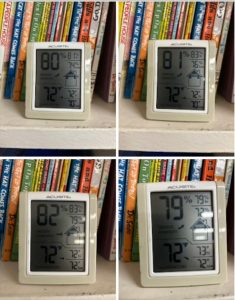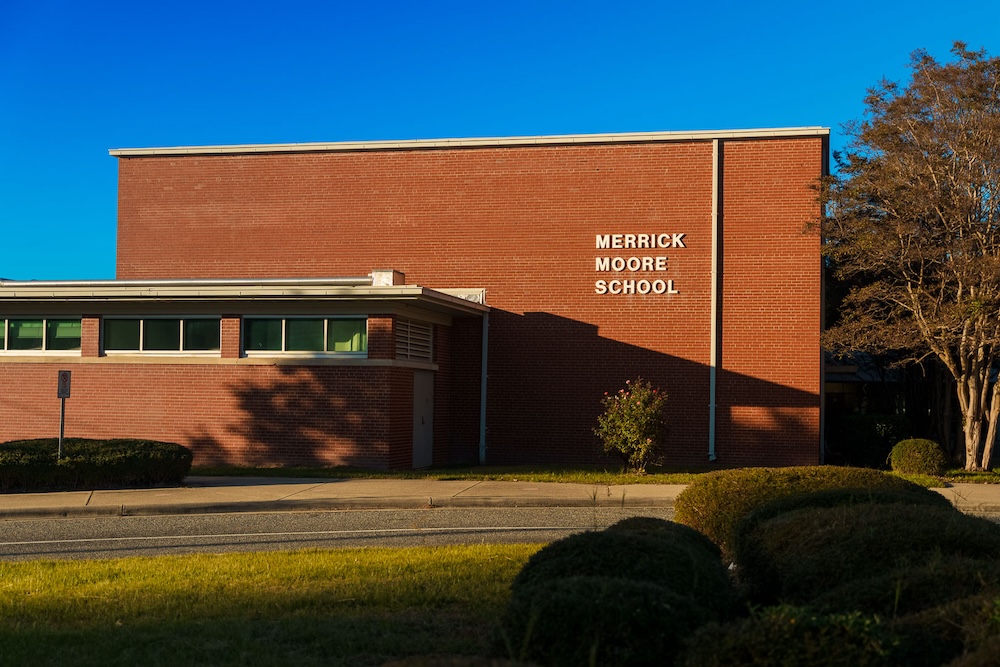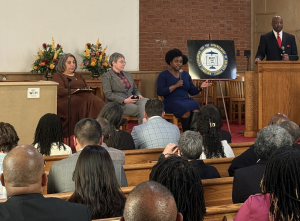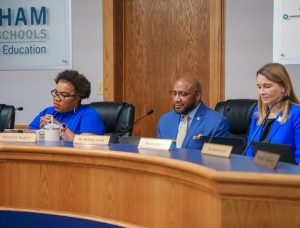On Sept. 17, Brittany Thomas received a text message from a distressed teacher at Merrick-Moore Elementary School. The air conditioning had broken down at Merrick-Moore, where Thomas is PTA president, and teachers were so uncomfortable that many threatened to call out of work, the teacher said.
“Can you please help us?” Thomas recalls him asking. “It’s 80 degrees and teachers are sweating through their clothes and the kids can’t learn…the front desk staff is saying they feel sick because they’re so hot.”
Brittany and her husband Aaron say they called the district and met with the school’s interim principal. Yet more than a week went by, and the heat did not subside.
Merrick-Moore is just the latest Durham elementary school grappling with HVAC failures. At other schools, parents have been urging the school system for months to address broken air conditioning and other maintenance issues. Now some are demanding long-term solutions, worried that their public schools are becoming unsafe learning environments.
 Hot and bothered
Hot and bothered
For more than a week, the Thomases’ third- and fifth-graders returned home daily drenched in sweat. Frustrated, the couple took matters into their own hands. On Sept. 25, they arrived at the school at 7:30 a.m. carrying two large fans for their children’s classrooms.
“I was really struck by how hot and how humid and just how unpleasant it was in the building,” Aaron Thomas said. Students were sent home at noon that day due to the heat.
On Sept. 26, as indoor temperatures remained high, Aaron Thomas contacted Millicent Rogers, who chairs the Durham school board.
“There are kids there with asthma, there are kids with sickle-cell anemia, there are teachers that are pregnant, there are teachers going through menopause,” he wrote. “This is not an environment they should be forced to stay in.”
Rogers responded that day, acknowledging his concerns. “This is not the experience we want students and educators to endure,” she replied. “Administration is working as quickly and diligently as possible to provide longer term solutions.”
Aaron was not satisfied. “I think she was trying her best to make me feel better,” he said. “But I wanted a timeline and specific next steps, and that was not what we got.”
On Sept. 27, the air conditioning at Merrick-Moore finally roared back to life after the 11-day outage.
“HVAC and chiller issues at Merrick-Moore have been addressed,” Clifton Williams, DPS Facilities and Operations Director, wrote in an email statement, responding to an inquiry from The 9th Street Journal. “The repair was completed on September 27, 2024, and the chiller is now operating and cooling all areas of the school.”
But after the HVAC repair, temperatures swung in the opposite direction, said Brittany Thomas. “My daughter was shivering in school because now the building was 64 degrees.”
Broader Concerns
Meanwhile, parents at other Durham elementary schools are raising similar concerns about ongoing maintenance problems.

Theresa Dowell Blackinton, a mother of two at Club Boulevard Elementary and former PTA president, said the school’s HVAC system continues to deteriorate. District leaders postponed planned renovations at Club and three other elementary schools in 2023 to pay for the increased costs of building a new Durham School of the Arts, now budgeted at more than $240 million.
Blackinton first raised concerns about conditions at Club five years ago, she says. Since then, she has repeatedly met with district and school administrators to request a timeline for school renovations. She says the school’s HVAC system consistently malfunctions.
The district has taken some action to address maintenance and HVAC concerns at its schools. The school system has spent more than $15 million dollars on IAQ (Indoor Air Quality) improvements over the last two years, Williams said in an email statement to The 9th Street Journal. In May, Durham school leaders devoted an additional $2 million in federal funds for HVAC and building repairs. The district also approved a $1.7 million contract with a consulting firm, Turner & Townsend Heery, to assess building deficiencies.
But Dowell Blackinton worries that the district is wasting money on temporary fixes rather than addressing root causes.
“Pretty much every day, they have to call it in,” she said. “Someone comes over, makes a temporary fix, and then that starts again the next day. But the obvious solution is replacing the HVAC system. They’re just tossing things down the road that still have to be done, but also spending all this money in the meantime.”
Temperatures are not the only concern — humidity levels are so severe that teachers are tracking daily readings in a spreadsheet, said Dowell Blackinton. Classroom roofs are leaking, books and papers are curling, and paint is peeling off the walls, she added.
“The kindergarteners were doing a basic activity, and they could not cut their paper because it was so humid and the paper was so wet,” she said.
Dowell Blackinton, who frequently volunteers at the school, has observed “fuzzy mold growth” on kindergarten bookshelves and in the art classroom. In August, she said, a kindergarten teacher had to bleach chairs and tables because of mold, while the school counselor had to discard moldy furniture.
“It’s a disaster,” she said. “We can’t keep sending our children into subpar environments and expecting them to learn.”
Clifton Williams, the school system’s facilities director, said the district is investigating complaints at Club.
“We are looking at areas throughout the building and discussing the next steps to address any items that were found,” he said in an emailed statement. “We have contacted a 3rd party contractor to do IAQ testing and suggest the next steps for remediation, if needed.”
“Currently, the HVAC system is operating and providing cooling in all areas of the school. Our department will continue to stay in contact with the school to address any repairs that need to be made,” he continued.
But Dowell Blackinton thinks it’ll take much more than temporary HVAC fixes.
“It’s going to continue to get worse,” she said.
“And then what happens when the building is at a breaking point here, or at Merrick-Moore, or E.K. Powe?” she asked. “What are they going to do with all of these students when the school is unusable and they’ve just let all this basic maintenance go?”
Lauren Sartain, a former PTA president at E.K. Powe Elementary School, was a vocal advocate when temperatures in her school exceeded 90 degrees last school year. Now she says she is disappointed, but not surprised, that schools across the district are still facing similar maintenance challenges.
“It seems unclear what the district’s longterm strategy is for dealing with these persistent building issues,” she said.
Parents seek clearer answers
Conditions at Merrick-Moore have now returned to normal, to the Thomases’ relief.
Still, they remain disappointed by an ongoing lack of communication, particularly from district leaders. They also wanted a clearer repair timeline.
Over their three years at Merrick-Moore, they say the air conditioning has broken down annually. But they often hear about it from their children and teachers — not the school.
“We’re both really big public school supporters in principle,” Brittany said. “But at the same time, it’s hard not to feel the need to go elsewhere when communication is just such a consistent issue.”
Above: Photos of Merrick-Moore Elementary by Kulsoom Rizavi — The 9th Street Journal
Storey Wertheimer





